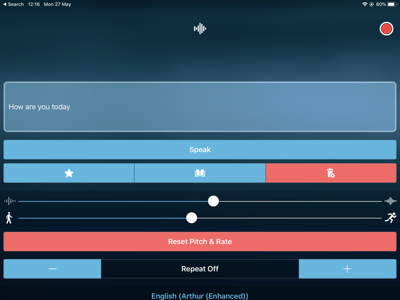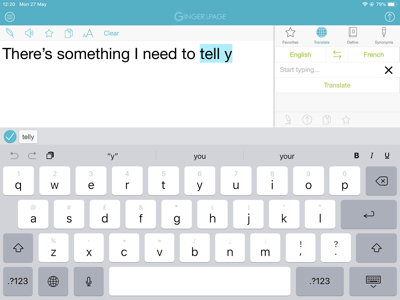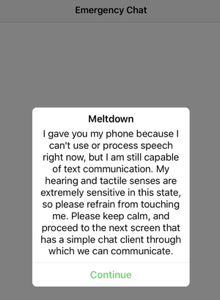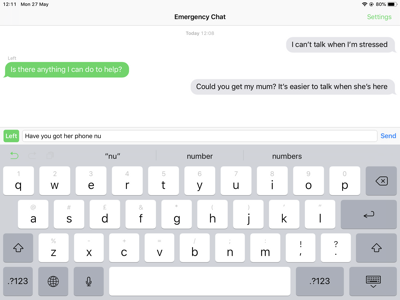Posted by Allan Wilson on the 24th May, 2019

I have had an occasional interest in Selective Mutism (SM) since before my days at CALL Scotland, when I worked in youth training and we had a trainee who refused to speak to anybody. In his case, it was due to a delay in his voice 'breaking' and the embarrassment of speaking with a high, 'squeaky' voice. He was 18 when his voice finally changed, after which he hardly ever stopped talking!
According to NHS guidance, "Selective mutism is a severe anxiety disorder where a person is unable to speak in certain social situations, such as with classmates at school or to relatives they don't see very often." Interestingly, the guidance makes no mention of the use of technology to support somebody with SM.
The Learner
We recently received an enquiry from an Educational Psychologist seeking advice on technology that might support a young person with SM and autism. At school, she is very anxious and communicates with staff by using written notes: at home, where she feels comfortable, she uses rich language with family and friends and has a wide vocabulary. She is interested in technology.
The Research
The research evidence regarding the use of technology to support people with SM isn't very broad, or directly relevant to this situation.
Augmentative and Alternative Communication for Speaking Autistic Adults: Overview and Recommendations by Zisk and Dalton suggests that the use of AAC could help in some situations, but there is a need for further research. Here are a couple of quotes:
- "For some people, and in some situations, simply writing or typing is sufficient, without needing an application that is specifically designed for AAC."
- "However, autistic adults who can speak describe significant benefits from the use of AAC strategies, sometimes designing their own applications."
Investigating Technology for Children with Selective Mutism by Manivannam and Fails tries "to identify technology characteristics that could be used to help children with SM communicate", but they don't actually use communication technology with children with SM. Nevertheless, they conclude that:
- "Children with SM interact normally with technology, which reduces their anxiety."
- "By using the stimulus method, children could use technology as a way to slowly start communicating in different settings."
Anecdotal Evidence
Anecdotal evidence is also mixed. I subscribe to QIAT, a US-based, but international, email discussion group on assistive technology in education, where there have been regular discussions on selective mutism over the years. You can find many of these in their archive, though when I had a look, some of the most recent discussions weren't appearing. Here are some quotes from these:
- "I have had two individuals with selective mutism. In both cases, the individual interacted with a/any device as much as she would speak. In more comfortable environments, the individuals would speak more, and use a communication app more. In uncomfortable environments the opposite was true. So, in these two cases AAC did not help augment their communication because in comfortable environments they did not need AAC, and in uncomfortable ones they wouldn't use it."
- "I have had several students with selective mutism, who were later diagnosed with ASD. I was told by the SLP that AAC was not usually successful for children with selective mutism, as the student does not want to communicate, and is not a function of ability to communicate."
- "I'm working with a student whose profile is similar in some ways, but perhaps a little different. She's a fourth grader with Down Syndrome and a history of SM (no talking at school for 18 months til the end of second grade). In her case, with the SM resolved, poor intelligibility is also problematic. I.e. She has anxiety about speaking, she speaks, her messages are difficult to understand even to familiar listeners, and she "shuts down." SM hasn't been an issue in two years, but she continues to demonstrate marked anxiety around speaking in certain situations (e.g. more confidence talking to peers, difficulty with clarifying and novel listeners). I am also an SLP, and I also have learned that the current perspective on SM is rightly and predominantly psychological. The parents, home SLP, and home and school teams have determined to move forward with AAC, in the hope that it will promote successful communication and thus reduce overall anxiety about speech. Initial explorations with AAC have been promising. Still, we're bearing inundated best practice for SM (e.g. positive reinforcement of communication attempts) and monitoring closely given the interplay of speech/language and psychological factors."
- "One student in particular came to me in 6th grade, with 3 PECS symbols, had developed significant SIBs and agrressive behaviors toward staff at his previous placement. I immediately introduced a flip book, that the student was able to use independently and would use working with me or the paraprofessional in the resource setting. I then referred the student for an SGD. During the trail the student was able to teach me where language was, but he would not utilize the device in the gen ed room or the community, supposedly based on his anxiety."
- "I have been working with a student who I met when in K. He repeated K and is now in 1st. He has yet to speak at school and primarily speaks to his mother at home and his father infrequently. With this student we tried using a flip-n-talk with topic vocabulary to support instructional vocabulary and a 54 core board to support phrase and sentence creation. He also has a portable electronic keyboard (PEK) with voice output. The student is able to type his responses/ comments and use the voice output feature to vocalize. Of the two options, the student prefers the PEK. He uses it consistently throughout the day. The SLP works with the student to address the SM utilizing ASHA recommendations."
Thoughts on Technology and Selective Mutism
Here are my own fairly random thoughts, but I should stress that I am not an expert on selective mutism:
General points
- Selective mutism is primarily related to feelings of extreme stress and anxiety, so these are the issues that need to be addressed.
- Technology may be able to help in some cases, but any decision on trying it should be influenced by the young person's attitude to technology - if she likes technology and is comfortable using it, it may well be worth trying, but if she is uncomfortable with it and use might lead to an increase in stress, then I wouldn't go down this route.
- Many Augmentative and Alternative Communication systems use symbols to help people who have difficulty with text, but as she is obviously comfortable with text, a text-based solution would probably be the best route for her.
Ipad / iPhone
The iPad / iPhone has a built-in text to speech facility (Speak Selection, accessed through Settings - General - Accessibility - Speech), which is excellent for reading short passages of text from the screen. For this young person, it would probably work best in conjunction with the Notes app, which includes a Speak Sentence option, otherwise it can be a little fiddly to select text to be spoken.
There are lots of apps that could also be used - here are a few:
- Speak Speech Synthesiser is a free app that allows the user to type, store and read back sentences. They can either be simple "chat" sentences, e.g. "How are you today?", "Did you see Game of Thrones, last night?", "I liked the bit where...", etc., or a longer piece, e.g. about something she's interested in, or about something that she was doing at the weekend. The one drawback of the app is that every time you speak a sentence it is saved again, so you can easily end up with lots of copies of "How are you today?". She would need to get in the habit of deleting the duplicates.

- Page Grammar Spell Checker costs £4.99 and provides more facilities than she would actually need, but it would allow her to take part in unprepared chat, typing with word prediction to increase speed if her typing is slow and a simple button to read the text out.

- Emergency Chat is a free app that can be used in situations where communication has broken down - it would certainly be worth looking at, particularly as the opening screen could be used to explain to a communication partner why she has difficulty speaking, so they will be patient and understanding when working with her. (A laminated card, with a summary of why she finds it hard to speak, that she could show people might also be useful.)


- Siri is the iPad / iPhone's built-in speech recognition system. Most people use it for asking questions, finding directions, etc., but it can also be used for generating text. It would have to be introduced carefully, giving somewhere private where she can dictate text, e.g. into Notes when nobody is around and then read it back using Speak Sentence when with the teacher. Over time, she might start to wonder if she could save time by dictating (i.e. speaking) directly to the teacher, rather than using Siri, but this is probably being optimistic!
Windows PC
Despite reservations about portability and the time taken to turn a laptop on and open software, it is likely that the pupil will have access to a PC in class, or with a teacher, and there are programs that can help.
- Microsoft Word now has Learning Tools, including a Read That option for reading out text. The voices available for Read That aren't great - "posh" English. If you are using Word Online, she may be able to use the Dictate speech recognition in the same way as Siri, above. Dictate has been available in Word and OneNote Online for several months, but schools in some local authorities are not able to access it. We are not sure if this is because it is blocked by the local authority, or because the software hasn't been updated. This is usually done automatically, but it may be that updates have been turned off.
- NaturalReader has a free version which can be used either as a Floating Toolbar, or in Full Page mode. NaturalReader can use the Scottish computer voices - Heather would be appropriate, though a new Scottish female child voice, Mairi, will be available soon. If she is using Word, but wants to use a Scottish voice, she could do this using NaturalReader. The Floating Toolbar would allow her to select text with a mouse and read it out loud by clicking on the Play button. Full Screen mode might be better for longer pieces of prepared text.
- Clicker would be a good option if it is already in the school as it has a friendly interface, word prediction and text to speech output. It is an excellent program with lots of excellent features, but is quite expensive and she probably wouldn't need many of these features so I wouldn't recommend it unless it is already in the school.
Further Information
The Selective Mutism Association web site has some useful information for educators.
The NHS guidance on Selective Mutism is pretty good - though there's no mention of technology!
 Newsletter: join thousands of other people
Newsletter: join thousands of other people






Our social media sites - YouTube, Twitter and Facebook